良好的实验动物给药和采血(包括途径和体积)规范指南
常用动物实验操作指南
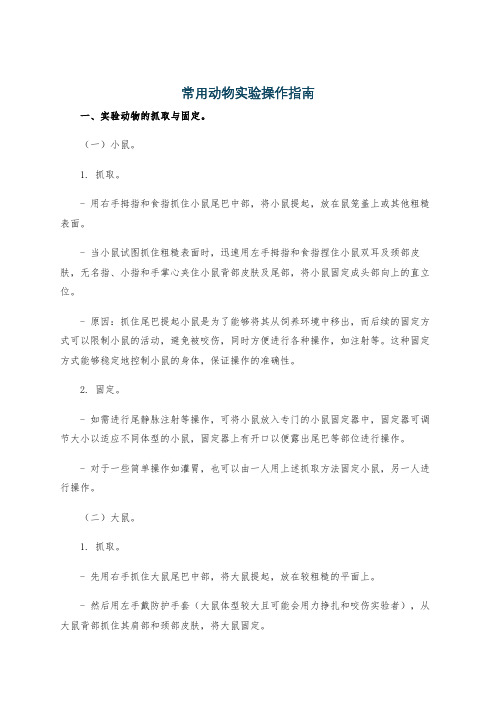
常用动物实验操作指南一、实验动物的抓取与固定。
(一)小鼠。
1. 抓取。
- 用右手拇指和食指抓住小鼠尾巴中部,将小鼠提起,放在鼠笼盖上或其他粗糙表面。
- 当小鼠试图抓住粗糙表面时,迅速用左手拇指和食指捏住小鼠双耳及颈部皮肤,无名指、小指和手掌心夹住小鼠背部皮肤及尾部,将小鼠固定成头部向上的直立位。
- 原因:抓住尾巴提起小鼠是为了能够将其从饲养环境中移出,而后续的固定方式可以限制小鼠的活动,避免被咬伤,同时方便进行各种操作,如注射等。
这种固定方式能够稳定地控制小鼠的身体,保证操作的准确性。
2. 固定。
- 如需进行尾静脉注射等操作,可将小鼠放入专门的小鼠固定器中,固定器可调节大小以适应不同体型的小鼠,固定器上有开口以便露出尾巴等部位进行操作。
- 对于一些简单操作如灌胃,也可以由一人用上述抓取方法固定小鼠,另一人进行操作。
(二)大鼠。
1. 抓取。
- 先用右手抓住大鼠尾巴中部,将大鼠提起,放在较粗糙的平面上。
- 然后用左手戴防护手套(大鼠体型较大且可能会用力挣扎和咬伤实验者),从大鼠背部抓住其肩部和颈部皮肤,将大鼠固定。
- 原因:大鼠力量较大,戴手套是为了保护实验者。
先抓尾巴提起是为了便于后续的抓取固定操作,从背部抓住肩部和颈部皮肤可以有效限制大鼠的活动,使其头部和身体得到控制,便于进行实验操作。
2. 固定。
- 对于需要长时间操作的情况,可将大鼠放入大鼠固定架中,固定架可以固定大鼠的四肢,使大鼠呈仰卧或俯卧位,根据实验需求调整。
- 在进行一些短期操作如皮下注射时,可由实验者用上述抓取方法固定大鼠,助手协助进行操作。
二、实验动物的给药操作。
(一)口服给药。
1. 小鼠灌胃。
- 准备合适的灌胃针(一般为1 - 2ml注射器连接特制的灌胃针头)。
- 将小鼠固定如前所述,使小鼠头部向上。
- 灌胃针从小鼠嘴角插入口腔,沿上腭后壁轻轻推进食管,插入深度约为3 - 4cm(根据小鼠大小调整)。
- 缓慢推动注射器活塞,将药物注入食管,然后缓慢拔出灌胃针。
良好的实验动物给药和采血包括途径和体积规范指南

良好的实验动物给药和采血包括途径和体积规范指南The Standardization Office was revised on the afternoon of December 13, 2020A Good Practice Guide to the Administration of Substances and Removal of Blood,IncludingRoutes and Volumes良好的实验动物给药和采血(包括途径和体积)规范指南Karl-Heinz Diehl1, Robin Hull2, David Morton3, Rudolf Pfister4, Yvon Rabemampianina5,David Smith6,*, Jean-Marc Vidal7 and Cor van de Vorstenbosch 81Aventis, PO Box 1140, D35001 Marburg, Germany德国马尔堡市35001区1140信箱安万特公司2N I B S C, Blanch Lane, South Miimms, Potters Bar, Hertfordshire EN6 3QG英国赫特福德郡EN6 3QG波特斯巴镇South Miimms布兰奇道英国国家生物制品检定所3The University of Birmingham, Medical School, Edgbaston, Birmingham B15 2TT英国伯明翰市B15 2TT艾吉马斯顿伯明翰大学医学院4Novartis Pharma AG, CH-4002 Basel, Switzerland瑞士巴塞尔CH-4002诺华制药公司5Centre de Recherche Pfizer, Etablissement d’Amboise, Z1 Poce´-sur-Cisse-BP 159 37401 Amboise Cedex, France法国Amboise Cedex Z1 Poce´-sur-Cisse-BP 159 37401 Etablissement d’Amboise 辉瑞研究中心6AstraZeneca R&D Charnwood, Bakewell Road, Loughborough, Leics LE11 5RH英国莱斯特郡LE11 5RH拉夫堡市贝克韦尔路Charnwood阿斯利康研究中心7Aventis, 102 Route de Noisy, 95235 Romainville Ce´dex, France法国Romainville Ce´dex 95235 Noisy路102号安万特公司8N V Organon, PO Box 20, 5340 BH Oss, Netherlands荷兰BH Oss5340 20号信箱欧加农公司Key words: blood volumes; blood removal; administration substances; laboratory animals; refinement.关键词:血容量;采血;给药;实验动物;简化This article is the result of an initiative between the European Federation of Pharmaceutical Industries Associations (EFPIA) and the European Centre for the Validation of Alternative Methods (ECVAM).Its objectives are to provide the researcher in the safety evaluation laboratory with an up-to-date, easyto-use set of data sheets to aid in the study design process whilst at the same time affording maximum welfare considerations to the experimental animals.该文章为欧盟制药工业协会(EFPIA)和欧洲替代动物实验方法验证中心(ECVAM)之间的初步结果。
动物实验操作基本方法

家兔的固定方 式有腹卧式和 仰卧式两种
LOGO
•犬的捉持 犬的捉持
实验者先抚摩, 实验者先抚摩, 逐步接近, 逐步接近,勿 使其惊恐或将 其激怒。 其激怒。
用粗棉绳兜住 狗的下颌, 狗的下颌,并 在上颌打结 (勿太紧)。 勿太紧)。
如犬不合作, 如犬不合作, 则先用一根特 制长柄狗头夹, 制长柄狗头夹, 从后面夹住犬 颈,限制犬头 部活动,再按 部活动, 上述方法捆住 犬嘴。 犬嘴。
腹主动脉采血
1 2 3 4 5 6
LOGO
1
尾尖采血
方法: 方法:固定动物并露出鼠尾,将尾部在45℃的温水中 浸泡数分钟(或以二甲苯棉球涂擦),使尾部血管扩 张。将鼠尾擦干,用锐器切去尾尖0.3~0.5cm,让血 液滴入盛器或直接以血红蛋白吸管吸取。 对象: 对象:大、小鼠 特点: 特点:小量采血,可以多次采血。
首先戴好防护 手套
用右手拇指和 食指抓住大鼠 尾巴中部将大 鼠提起, 鼠提起,放在 大鼠饲养盒的 面罩上。 面罩上。
左手顺势按、 左手顺势按、 卡在大鼠躯干 背部, 背部,稍加压 力向头颈部滑 行。
LOGO
•豚鼠的捉持 豚鼠的捉持
先用左手轻轻 扣、按住豚鼠 背部。 背部。
用右手食指将 针栓慢慢往下 压,将注射器 中的药液灌入 动物的胃中。 动物的胃中。
左手捉持动物, 左手捉持动物, 使头部向上。 使头部向上。 1、将灌胃针连 接在注射器上, 接在注射器上, 吸入一定量的 药液。 药液。
右手持针,把 右手持针, 灌胃针头的前 端放进动物的 口腔, 口腔,顺着上 腭部插入咽部, 腭部插入咽部, 顺咽后壁轻轻 往下推。 往下推。
鼠4~5mm。当感到有阻力时再稍后退,得到所需要的血量 后,拔出。 对象: 对象:大、小鼠等。 特点: 特点:中等血量(0.2~0.3ml,小鼠;0.5~1.0ml,大白 鼠),避免动物死亡。 。
实验动物使用操作规程

四、动物实验及设施设备操作规程1、屏障设施使用操作规程(1)人员进出进入一更前将头发盘起,在更衣室外消毒槽站立片刻换拖鞋进入一更,关闭一更门,将门反锁。
脱下外衣放入更衣柜,更换为灭菌后内衣,将一更门解锁。
打开二更门,更换二更拖鞋,进入二更,以感应式消毒器对手消毒,戴口罩、帽子,头发应全部塞入帽子里,消毒液洗手,戴无菌手套,然后穿隔离衣。
以手套将隔离衣袖口封紧。
在消毒液内擦洗手套,要将手套表面指缝、腕部仔细擦洗。
实验人员进入动物实验室,更换各自实验室的拖鞋。
每天操作完毕,各实验室拖鞋于消毒液中洗净取出于本室晾干。
摘去手套,将手套整体泡入另一消毒盒内,关闭二更内侧门,换拖鞋。
将二更外侧门边放置的拖鞋拿到内侧门边摆放整齐,人员即可离开,离开前将拖鞋在消毒液中浸泡5分钟。
进入一更,脱去无菌内、外衣,更换自己衣服,出一更,将无菌衣拿出。
开一更、二更紫外灯消毒。
每次进出动物实验室须填写记录表。
(2)物品进出外购的饲料经紫外灯照射20—30分钟后传入内储存室。
饲料在实验区内存放,不能超过两周。
夏季注意防霉防潮。
垫料经双扉高压蒸汽灭菌柜灭菌后传入内储存室。
小件笼具等经双扉高压蒸汽灭菌柜灭菌后传入内储存室。
大件笼具经消毒浸泡后,再喷雾消毒三遍方可进入。
不能耐高温物品如消毒液瓶等,将外表擦拭干净后,用消毒液浸泡消毒,由传递窗进入饲养室准备间。
所有实验用品先用消毒剂进行表面灭菌或喷雾灭菌后再放入传递窗中经紫外灯照射20—30分钟后从内储存室侧取出。
待洗刷物品经内储存室传入消毒室。
废弃物、动物排泄物装入塑料袋,密封后经污物传递窗传出。
实验结束后,实验用品通过内储存室传递窗传出。
(3)动物管理动物进入:动物引进应先放入隔离检疫室,待隔离检疫合格后移入饲养室。
动物进入洁净区前,首先按照动物运输箱上的标签,核对动物的出生日期、品系名称、性别、数量、供应单位名称、动物的微生物控制等级等是否与计划相符。
用消毒液如5%百毒杀、0.5%~1%过氧乙酸等喷雾消毒运输箱的表面。
实验动物采血完全指南

实验动物采血完全指南凡用血量较少的检验如红、白细胞计数、血红蛋白的测定,血液涂片以及酶活性微量分析法等,可刺破组织取毛细血管的血。
当需血量较多时可作静脉采血。
静脉采血时,若需反复多次,应自远离心脏端开始,以免发生栓塞而影响整条静脉。
例如,研究毒物对肺功能的影响、血液酸碱平衡、水盐代谢紊乱,需要比较动、动脉血氧分压、二氧化碳分压和血液pH值以及K+、Na+、CI-离子浓度,必须采取动脉血液。
采血时要注意:⑴采血场所有充足的光线;室温夏季最好保持在25-28℃,冬季,15-20℃为宜;⑵采血用具有采用部位一般需要进行消毒;⑶采血用的注射器和试管必须保持清洁干燥;⑷若需抗凝全血,在注射器或试管内需预先加入抗凝剂.1.取少量血a.尾静脉大鼠、小鼠b.耳静脉兔、狗、猫、猪、山羊、绵羊c.眼底静脉丛兔、大鼠、小鼠c.舌下静脉兔d.腹壁静脉青蛙、蟾蜍e.冠、脚蹼皮下静脉鸡、鸭、鹅2.取中量血a.后肢外侧皮下小隐静脉狗、猴、猫b.前肢内侧皮下头静脉狗、猴、猫c.耳中央动脉兔d.颈静脉狗、猫、兔e.心脏豚鼠、大鼠、小鼠f.断头大鼠、小鼠g.翼下静脉鸡、鸭、鸽、鹅h.颈动脉鸡、鸭、鸽、鹅3.取大量血a.股动脉、颈动脉狗、猴、猫、兔b.心脏狗、猴、猫、兔c.颈静脉马、牛、山羊、绵羊d.摘眼球大鼠、小鼠采动物品种最大安全采血量(ml) 最小致死采血量(ml)小鼠0.2 0.3大鼠 1 2豚鼠 5 10兔10 40狼狗100 500猎狗50 200猴15 601.割(剪)尾采血当所需血量很少时采用本法。
固定动物并露出鼠尾。
将尾部毛剪去后消毒,然后浸在45℃左右的温水中数分钟,使尾部血管充盈。
再将尾擦干,用锐器(刀或剪刀)割去尾尖0.3-0.5cm,让血液自由滴入盛器或用血红蛋白吸管吸取,采血结束,伤口消毒并压迫止血。
也可在尾部作一横切口,割破尾动脉或静脉,收集血液的方法同上。
每鼠一般可采血10余次以上。
小鼠每次可取血0.1ml,大鼠0.3~0.5ml。
采血安乐死麻醉,这么全的实验动物指导方针一定要收藏!

采血安乐死麻醉,这么全的实验动物指导方针一定要收藏!导读常见实验动物指导方针:一、常见动物血液采集二、安乐死的指导方针三、常见动物麻醉的指导方针一、常见动物血液采集网站:/services-name/research-animal-resources/research-support/guidelines/blood-collection本网站收集的常见动物有以下:(点击各动物前的+号可以查看详情)1、小鼠血液采集2、大鼠血液采集3、小鼠和大鼠血液采集总结4、兔血液采集5、啮齿动物常见的采血程序介绍点击各动物前的+号,可以查看详细的采血步骤。
二、安乐死的指导方针网址:/services-name/research-animal-resources/research-support/guidelines/euthanasia本网站收集的常见动物有以下:(点击对应的物种,可以跳转到查看具体的安乐死方式)1、老鼠、老鼠、沙鼠、仓鼠或其他小啮齿动物安乐死方式① Carbon dioxide (CO2)Inhalation to effect. Flow rate must displace no more than 30% of the chamber volume/minute. Prolonged exposure may be required for neonates and fetuses.② Sodium pentobarbital(戊巴比妥钠)≥100 mg/kg intraperito neal (IP) or intravenous (IV). This is a controlled substance (DEA Schedule II). Dosing is the same for the commercial product Fatal-Plus®.③ Euthanasia solution(安乐死溶液)≥86 mg/kg IP or IV. Multiple pharmaceutical grade products available. Contains sodium pentobarbital 390 mg/ml + sodium phenytoin 50 mg/ml (dosing based on barbiturate concentration). This is a controlled substance (DEA Schedule III).④ Cervical dislocation(颈椎脱位)Use in conscious small rodents requires demonstrated technical skill (or must be performed only on unconscious/anesthetized small rodents). Use in rats >200 g to be performed under anesthesia only.⑤ Decapitation(断头)Use in conscious small rodents requires demonstrated technical skill (or must be performed only on unconscious/anesthetized small rodents). Use in rats >200 g to be performed under anesthesia only.⑥ Isoflurane overdose(异氟醚过量)Inhalation to effect. May require prolonged exposure to ensure death.⑦ Injectable anesthetic overdose(注射麻醉过量)Administration varies (IP or IV). Consult a Research Animal Resources (RAR) veterinarian regarding specific agents.⑧ Anesthesia followed by potassium chloride(麻醉后氯化钾)75-150 mg/kg KCl IV. Administer rapidly to effect.⑨ Anesthesia followed by physical method(麻醉后物理方法)Cervical dislocation, decapitation, exsanguination, bilateral pneumothorax.2、兔安乐死方式① Sodium pentobarbital(戊巴比妥钠)≥100 mg/kg IP or IV. This is a controlled substance (DEA Schedule II). Dosing is the same for the commercial product Fatal-Plus®.② Euthanasia solution(安乐死溶液)≥86 mg/kg IP or IV. Multiple pharmaceutical grade products available. Contains sodium pentobarbital 390 mg/ml + sodium phenytoin 50 mg/ml (dosing based on barbiturate concentration). This is a controlled substance (DEA Schedule III).③ Injectable anesthetic overdose(注射麻醉过量)Administration varies (IP or IV). Consult an RAR veterinarian regarding specific agents.④ Anesthesia followed by potassium chloride(麻醉后氯化钾)75-150 mg/kg KCl IV. Administered rapidly to effect.⑤ Anesthesia followed by physical method(麻醉后物理方法)Cervical dislocation, decapitation, exsanguination, bilateralpneumothorax三、常见动物麻醉的指导方针网址:/services-name/research-animal-resources/research-support/guidelines/analgesia此网站记录麻醉方式的物种有以下:1、小鼠麻醉方式小鼠麻醉指南,包括麻醉药物和程序和对新生小鼠麻醉特殊考虑。
药理实验中对动物的给药体积与采血体积控制
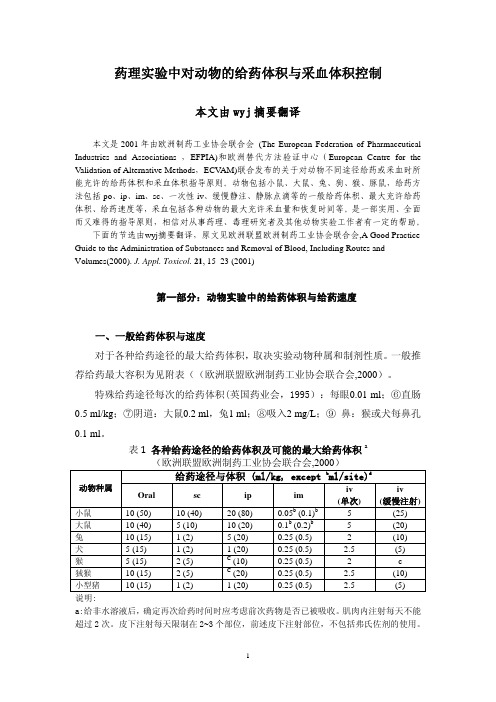
药理实验中对动物的给药体积与采血体积控制本文由wyj摘要翻译本文是2001年由欧洲制药工业协会联合会 (The European Federation of Pharmaceutical Industries and Associations ,EFPIA)和欧洲替代方法验证中心(European Centre for the Validation of Alternative Methods,ECV AM)联合发布的关于对动物不同途径给药或采血时所能充许的给药体积和采血体积指导原则。
动物包括小鼠、大鼠、兔、狗、猴、豚鼠,给药方法包括po、ip、im、sc、一次性iv、缓慢静注、静脉点滴等的一般给药体积、最大充许给药体积、给药速度等,采血包括各种动物的最大充许采血量和恢复时间等。
是一部实用、全面而又难得的指导原则,相信对从事药理、毒理研究者及其他动物实验工作者有一定的帮助。
下面的节选由wyj摘要翻译,原文见欧洲联盟欧洲制药工业协会联合会,A Good Practice Guide to the Administration of Substances and Removal of Blood, Including Routes and Volumes(2000). J. Appl. Toxicol. 21, 15–23 (2001)第一部分:动物实验中的给药体积与给药速度一、一般给药体积与速度对于各种给药途径的最大给药体积,取决实验动物种属和制剂性质。
一般推荐给药最大容积为见附表((欧洲联盟欧洲制药工业协会联合会,2000)。
特殊给药途径每次的给药体积(英国药业会,1995):每眼0.01 ml;⑥直肠0.5 ml/kg;⑦阴道:大鼠0.2 ml,兔1 ml;⑧吸入2 mg/L;⑨鼻:猴或犬每鼻孔0.1 ml。
表1各种给药途径的给药体积及可能的最大给药体积a(欧洲联盟欧洲制药工业协会联合会,2000)给药途径与体积 (ml/kg, except b ml/site)d动物种属Oral sc ip imiv(单次)iv(缓慢注射)小鼠10 (50) 10 (40) 20 (80) 0.05b (0.1)b 5 (25) 大鼠10 (40) 5 (10) 10 (20) 0.1b (0.2)b 5 (20) 兔10 (15) 1 (2) 5 (20) 0.25 (0.5) 2 (10)犬 5 (15) 1 (2) 1 (20) 0.25 (0.5) 2.5 (5)猴 5 (15) 2 (5) C (10) 0.25 (0.5) 2 c狨猴10 (15) 2 (5) C (20) 0.25 (0.5) 2.5 (10)小型猪10 (15) 1 (2) 1 (20) 0.25 (0.5) 2.5 (5)说明:a:给非水溶液后,确定再次给药时间时应考虑前次药物是否已被吸收。
良好的实验动物给药和采血(包括途径和体积)规范的指南

A Good Practice Guide to the Administration of Substances and Removal of Blood,Including Routesand Volumes良好的实验动物给药和采血(包括途径和体积)规范指南Karl-Heinz Diehl1, Robin Hull2, David Morton3, Rudolf Pfister4, Yvon Rabemampianina5,David Smith6,*, Jean-Marc Vidal7 and Cor van de Vorstenbosch 81Aventis, PO Box 1140, D35001 Marburg, Germany德国马尔堡市35001区1140信箱安万特公司2N I B S C, Blanch Lane, South Miimms, Potters Bar, Hertfordshire EN6 3QG英国赫特福德郡EN6 3QG波特斯巴镇South Miimms布兰奇道英国国家生物制品检定所3The University of Birmingham, Medical School, Edgbaston, Birmingham B15 2TT英国伯明翰市B15 2TT艾吉马斯顿伯明翰大学医学院4Novartis Pharma AG, CH-4002 Basel, Switzerland瑞士巴塞尔CH-4002诺华制药公司5Centre de Recherche Pfizer, Etablissement d’Amboise, Z1 Poce´-sur-Cisse-BP 159 37401 Amboise Cedex, France法国Amboise Cedex Z1 Poce´-sur-Cisse-BP 159 37401 Etablissement d’Amboise辉瑞研究中心6AstraZeneca R&D Charnwood, Bakewell Road, Loughborough, Leics LE11 5RH英国莱斯特郡LE11 5RH拉夫堡市贝克韦尔路Charnwood阿斯利康研究中心7Aventis, 102 Route de Noisy, 95235 Romainville Ce´dex, France法国Romainville Ce´dex 95235 Noisy路102号安万特公司8N V Organon, PO Box 20, 5340 BH Oss, Netherlands荷兰BH Oss5340 20号信箱欧加农公司Key words: blood volumes; blood removal; administration substances; laboratory animals; refinement.关键词:血容量;采血;给药;实验动物;简化This article is the result of an initiative between the European Federation of Pharmaceutical Industries Associations (EFPIA) and the European Centre for the Validation of Alternative Methods (ECVAM).Its objectives are to provide the researcher in the safety evaluation laboratory with an up-to-date, easyto-use set of data sheets to aid in the study design process whilst at the same time affording maximum welfare considerations to the experimental animals.该文章为欧盟制药工业协会(EFPIA)和欧洲替代动物实验方法验证中心(ECVAM)之间的初步结果。
良好的实验动物给药和采血(包括途径和体积)规范指南

A Good Practice Guide to the Administration of Substances and Removal of Blood,Including Routes andVolumes良好的实验动物给药和采血(包括途径和体积)规范指南Karl-Heinz Diehl1, Robin Hull2, David Morton3, Rudolf Pfister4, Yvon Rabemampianina5,David Smith6,*, Jean-Marc Vidal7 and Cor van de V orstenbosch 81Aventis, PO Box 1140, D35001 Marburg, Germany德国马尔堡市35001区1140信箱安万特公司2N I B S C, Blanch Lane, South Miimms, Potters Bar, Hertfordshire EN6 3QG英国赫特福德郡EN6 3QG波特斯巴镇South Miimms布兰奇道英国国家生物制品检定所3The University of Birmingham, Medical School, Edgbaston, Birmingham B15 2TT英国伯明翰市B15 2TT艾吉马斯顿伯明翰大学医学院4Novartis Pharma AG, CH-4002 Basel, Switzerland瑞士巴塞尔CH-4002诺华制药公司5Centre de Recherche Pfizer, Etablissement d’Amboise, Z1 Poce´-sur-Cisse-BP 159 37401 Amboise Cedex, France法国Amboise Cedex Z1 Poce´-sur-Cisse-BP 159 37401 Etablissement d’Amboise 辉瑞研究中心6AstraZeneca R&D Charnwood, Bakewell Road, Loughborough, Leics LE11 5RH英国莱斯特郡LE11 5RH拉夫堡市贝克韦尔路Charnwood阿斯利康研究中心7Aventis, 102 Route de Noisy, 95235 Romainville Ce´dex, France法国Romainville Ce´dex 95235 Noisy路102号安万特公司8N V Organon, PO Box 20, 5340 BH Oss, Netherlands荷兰BH Oss5340 20号信箱欧加农公司Key words: blood volumes; blood removal; administration substances; laboratory animals; refinement.关键词:血容量;采血;给药;实验动物;简化This article is the result of an initiative between the European Federation of Pharmaceutical Industries Associations (EFPIA) and the European Centre for the Validation of Alternative Methods (ECV AM).Its objectives are to provide the researcher in the safety evaluation laboratory with an up-to-date, easyto-use set of data sheets to aid in the study design process whilst at the same time affording maximum welfare considerations to the experimental animals.该文章为欧盟制药工业协会(EFPIA)和欧洲替代动物实验方法验证中心(ECV AM)之间的初步结果。
实验动物取血,尿液,其他体液的采集,实验动物的剖检方法
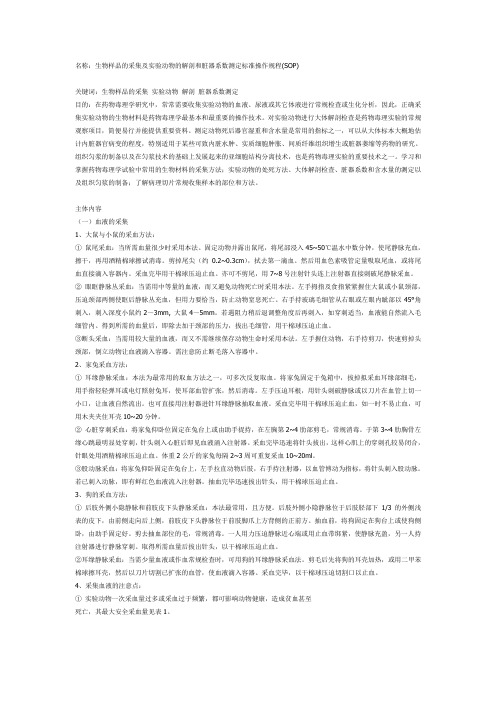
名称:生物样品的采集及实验动物的解剖和脏器系数测定标准操作规程(SOP)关键词:生物样品的采集实验动物解剖脏器系数测定目的:在药物毒理学研究中,常常需要收集实验动物的血液、尿液或其它体液进行常规检查或生化分析,因此,正确采集实验动物的生物材料是药物毒理学最基本和最重要的操作技术。
对实验动物进行大体解剖检查是药物毒理实验的常规观察项目,简便易行并能提供重要资料。
测定动物死后器官湿重和含水量是常用的指标之一,可以从大体标本大概地估计内脏器官病变的程度,特别适用于某些可致内脏水肿、实质细胞肿胀、间质纤维组织增生或脏器萎缩等药物的研究。
组织匀浆的制备以及在匀浆技术的基础上发展起来的亚细胞结构分离技术,也是药物毒理实验的重要技术之一。
学习和掌握药物毒理学试验中常用的生物材料的采集方法;实验动物的处死方法、大体解剖检查、脏器系数和含水量的测定以及组织匀浆的制备;了解病理切片常规收集样本的部位和方法。
主体内容(一)血液的采集1、大鼠与小鼠的采血方法:①鼠尾采血:当所需血量很少时采用本法。
固定动物并露出鼠尾,将尾部浸入45~50℃温水中数分钟,使尾静脉充血,擦干,再用酒精棉球擦试消毒。
剪掉尾尖(约0.2~0.3cm),拭去第一滴血。
然后用血色素吸管定量吸取尾血,或将尾血直接滴入容器内。
采血完毕用干棉球压迫止血。
亦可不剪尾,用7~8号注射针头连上注射器直接刺破尾静脉采血。
②眼眶静脉丛采血:当需用中等量的血液,而又避免动物死亡时采用本法。
左手拇指及食指紧紧握住大鼠或小鼠颈部,压迫颈部两侧使眶后静脉丛充血,但用力要恰当,防止动物窒息死亡。
右手持玻璃毛细管从右眼或左眼内眦部以45°角刺入,刺入深度小鼠约2~3mm, 大鼠4~5mm。
若遇阻力稍后退调整角度后再刺入,如穿刺适当,血液能自然流入毛细管内。
得到所需的血量后,即除去加于颈部的压力,拔出毛细管,用干棉球压迫止血。
③断头采血:当需用较大量的血液,而又不需继续保存动物生命时采用本法。
(完整word版)动物免疫与动物采血实验操作规范

动物免疫与动物采血一、动物保定在进行动物免疫和动物采血之前,进行动物保定是非常必要的。
正确的抓取固定动物是为了不损害动物健康,不影响观察指标,并防止被动物咬伤,保证试验顺利进行。
下面介绍几种常见实验动物的保定方法。
1 小鼠的抓取固定方法小鼠性情温顺,一般不会主动咬人,但取用时动作也要轻缓。
抓取时先用右手抓取鼠尾提起,放在其前,爪能抓牢的物体表面稍后提,或放在实验台上,在其向前爬行时,用左手拇食指迅速提住其后颈部皮肤,把鼠体置于左手心中,将鼠尾用无名指和小指压在手掌上。
右手即可进行各种操作,如注射、灌胃及其他实验操作。
如进行解剖、手术、心脏及尾部采血和尾静脉注射时,则需将小鼠做一定形式的固定,解剖手术和心脏采血等均可使动物先取背卧式(必要时先进行麻醉),再用大头针或线绳将鼠前后肢依次固定在支持物上。
尾静脉采血或尾静脉注射时,可用小鼠尾静脉注射架固定;或倒放适当大小和重量的容器,把小鼠放在里面只露尾巴,这种容器能够压住尾部不让活动,同时起,到驱赶血液的作用;或把小鼠放在一黑布口袋里小鼠趋黑,向前爬动,在尾部将小口袋缩口,固定小布口袋后,可进行尾静脉采血或尾静脉注射等操作。
如只想移动小鼠,可用两手把它捧起或用右手拇指和食指的指腹抓住尾部中央将小鼠倒提起来。
2 大鼠的抓取固定方法4-5周龄以内的大鼠和小鼠一样抓住尾部提起来,周龄较大的大鼠尾部皮肤因为容易被剥脱,所以用左手从背部中央到胸部捏起来抓住。
由于大鼠比小鼠牙尖性猛,不易用袭击方式抓取,以防大鼠在惊恐或击怒时咬伤手指,提拿时最好戴上防护手套,轻轻抓住尾巴后提起,置于试验台上,固定方法随操作目的而定。
如需尾静脉取血或注射,可将大鼠固定盒内或用小黑布口袋装大鼠,使其只露尾部;如需腹腔注射或肌肉注射或灌胃,可用右手提住鼠尾,将鼠放在鼠爪能抓牢的物体表面,如铁丝笼子,稍向后拉鼠尾、鼠身被拉长,用左手贴在鼠背,捏紧头顶部和背部皮肤,即可将大鼠固定在左手中,右手可进行其他操作;如需长时间固定操作,可将大鼠四肢固定在木板上,用一根棉绳拉住两只门齿固定在头部后木板上。
实验动物给药途经和剂量的管理规范

Guidelines for the Administration of Substances, Including Routes andVolumes给药途经和剂量的管理规范一、目的提供常用实验动物的采血、给药方法的指导规范,同时最大限度地减少动物痛苦和我们的烦恼二、背景计量实验动物是必要的各种科学调查,以满足监管要求。
这些准则旨在突出必要的考虑因素,并找出潜在的问题,将改进的技术,构成良好实验室实践。
最恰当的注射方法和剂量(可能的最大剂量)Species 种类Route and V olumes (ml/g except *ml/site)方法和剂量(毫升/克*毫升/注射点除外) Oral口腔SC皮下IP腹腔IM肌肉IV静脉(slow iv)Mouse 小鼠0.01(0.05) 0.01(0.04) 0.02(0.8)0.05*(0.1)*0.005(0.025)Rat 大鼠0.01(0.04)0.005(0.015 )0.01(0.02)0.1* (0.2)*0.005(0.02),Species 种类Route and V olumes (ml/kg except *ml/site)方法和剂量(毫升/千克*毫升/注射点除外Oral口腔SC皮下IP腹腔IM肌肉IV静脉(slow iv)Rabbit 兔子10 (15) 1 (2) 5 (20) 0.25 (0.5)2 (10)Pig 猪10 (15) 1 (2) 1 (20)0.25 (0.5)2.5 (5)Dog 狗5 (15) 1 (2) 1 (20) 0.25 (0.5)2.5 (5)注:•对于非水溶液制剂,必须考虑吸收时间,然后再进行下一次给药。
•每天肌注不超过2个点应该使用。
•皮下注射点应限制在每天2至3注射点。
•皮下注射不包括弗氏佐剂(见兔免疫指引)。
•列左侧的数字是打算作为一个推荐量为单个或多个剂量的指导。
第二组括号内的数字是可能的最大值。
实验动物采血完全指南
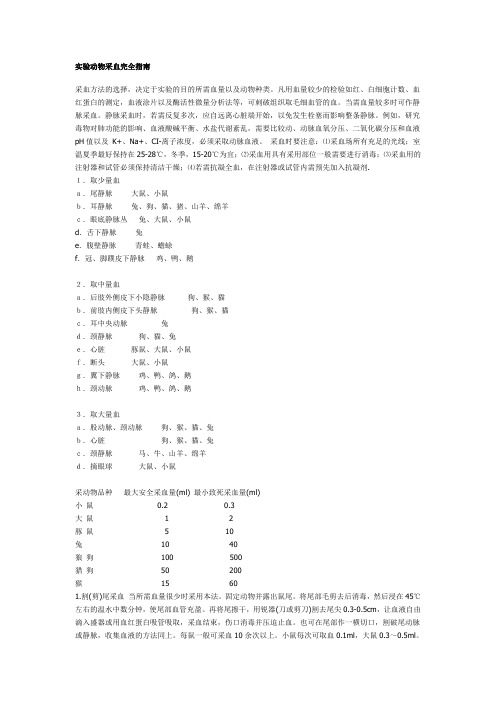
实验动物采血完全指南采血方法的选择,决定于实验的目的所需血量以及动物种类。
凡用血量较少的检验如红、白细胞计数、血红蛋白的测定,血液涂片以及酶活性微量分析法等,可刺破组织取毛细血管的血。
当需血量较多时可作静脉采血。
静脉采血时,若需反复多次,应自远离心脏端开始,以免发生栓塞而影响整条静脉。
例如,研究毒物对肺功能的影响、血液酸碱平衡、水盐代谢紊乱,需要比较动、动脉血氧分压、二氧化碳分压和血液pH值以及K+、Na+、CI-离子浓度,必须采取动脉血液。
采血时要注意:⑴采血场所有充足的光线;室温夏季最好保持在25-28℃,冬季,15-20℃为宜;⑵采血用具有采用部位一般需要进行消毒;⑶采血用的注射器和试管必须保持清洁干燥;⑷若需抗凝全血,在注射器或试管内需预先加入抗凝剂.1.取少量血a.尾静脉大鼠、小鼠b.耳静脉兔、狗、猫、猪、山羊、绵羊c.眼底静脉丛兔、大鼠、小鼠d.舌下静脉兔e.腹壁静脉青蛙、蟾蜍f.冠、脚蹼皮下静脉鸡、鸭、鹅2.取中量血a.后肢外侧皮下小隐静脉狗、猴、猫b.前肢内侧皮下头静脉狗、猴、猫c.耳中央动脉兔d.颈静脉狗、猫、兔e.心脏豚鼠、大鼠、小鼠f.断头大鼠、小鼠g.翼下静脉鸡、鸭、鸽、鹅h.颈动脉鸡、鸭、鸽、鹅3.取大量血a.股动脉、颈动脉狗、猴、猫、兔b.心脏狗、猴、猫、兔c.颈静脉马、牛、山羊、绵羊d.摘眼球大鼠、小鼠采动物品种最大安全采血量(ml) 最小致死采血量(ml)小鼠0.2 0.3大鼠 1 2豚鼠 5 10兔10 40狼狗100 500猎狗50 200猴15 601.割(剪)尾采血当所需血量很少时采用本法。
固定动物并露出鼠尾。
将尾部毛剪去后消毒,然后浸在45℃左右的温水中数分钟,使尾部血管充盈。
再将尾擦干,用锐器(刀或剪刀)割去尾尖0.3-0.5cm,让血液自由滴入盛器或用血红蛋白吸管吸取,采血结束,伤口消毒并压迫止血。
也可在尾部作一横切口,割破尾动脉或静脉,收集血液的方法同上。
良好地实验动物给药和采血(包括途径和体积)要求规范指南设计

A Good Practice Guide to the Administration of Substances and Removal of Blood,Including Routes andVolumes良好的实验动物给药和采血(包括途径和体积)规指南Karl-Heinz Diehl1, Robin Hull2, David Morton3, Rudolf Pfister4, Yvon Rabemampianina5,David Smith6,*, Jean-Marc Vidal7 and Cor van de V orstenbosch 81Aventis, PO Box 1140, D35001 Marburg, Germany德国马尔堡市35001区1140信箱安万特公司2N I B S C, Blanch Lane, South Miimms, Potters Bar, Hertfordshire EN6 3QG英国赫特福德郡EN6 3QG波特斯巴镇South Miimms布兰奇道英国国家生物制品检定所3The University of Birmingham, Medical School, Edgbaston, Birmingham B15 2TT英国伯明翰市B15 2TT艾吉马斯顿伯明翰大学医学院4Novartis Pharma AG, CH-4002 Basel, Switzerland瑞士巴塞尔CH-4002诺华制药公司5Centre de Recherche Pfizer, Etablissement d’Amboise, Z1 Poce´-sur-Cisse-BP 159 37401 Amboise Cedex, France 法国Amboise Cedex Z1 Poce´-sur-Cisse-BP 159 37401 Etablissement d’Amboise 辉瑞研究中心6AstraZeneca R&D Charnwood, Bakewell Road, Loughborough, Leics LE11 5RH英国莱斯特郡LE11 5RH拉夫堡市贝克韦尔路Charnwood阿斯利康研究中心7Aventis, 102 Route de Noisy, 95235 Romainville Ce´dex, France法国Romainville Ce´dex 95235 Noisy路102号安万特公司8N V Organon, PO Box 20, 5340 BH Oss, Netherlands荷兰BH Oss5340 20号信箱欧加农公司Key words: blood volumes; blood removal; administration substances; laboratory animals; refinement.关键词:血容量;采血;给药;实验动物;简化This article is the result of an initiative between the European Federation of Pharmaceutical Industries Associations (EFPIA) and the European Centre for the Validation of Alternative Methods (ECV AM).Its objectives are to provide the researcher in the safety evaluation laboratory with an up-to-date, easyto-use set of data sheets to aid in the study design process whilst at the same time affording maximum welfare considerations to the experimental animals.该文章为欧盟制药工业协会(EFPIA)和欧洲替代动物实验方法验证中心(ECV AM)之间的初步结果。
A good practice guide药理实验中对动物的给药体积与采血体积控制

药理实验中对动物的给药体积与采血体积控制本文由wyj摘要翻译本文是2001年由欧洲制药工业协会联合会 (The European Federation of Pharmaceutical Industries and Associations ,EFPIA)和欧洲替代方法验证中心(European Centre for the Validation of Alternative Methods,ECV AM)联合发布的关于对动物不同途径给药或采血时所能充许的给药体积和采血体积指导原则。
动物包括小鼠、大鼠、兔、狗、猴、豚鼠,给药方法包括po、ip、im、sc、一次性iv、缓慢静注、静脉点滴等的一般给药体积、最大充许给药体积、给药速度等,采血包括各种动物的最大充许采血量和恢复时间等。
是一部实用、全面而又难得的指导原则,相信对从事药理、毒理研究者及其他动物实验工作者有一定的帮助。
下面的节选由wyj摘要翻译,原文见欧洲联盟欧洲制药工业协会联合会,A Good Practice Guide to the Administration of Substances and Removal of Blood, Including Routes and Volumes(2000). J. Appl. Toxicol. 21, 15–23 (2001)第一部分:动物实验中的给药体积与给药速度一、一般给药体积与速度对于各种给药途径的最大给药体积,取决实验动物种属和制剂性质。
一般推荐给药最大容积为见附表((欧洲联盟欧洲制药工业协会联合会,2000)。
特殊给药途径每次的给药体积(英国药业会,1995):每眼0.01 ml;⑥直肠0.5 ml/kg;⑦阴道:大鼠0.2 ml,兔1 ml;⑧吸入2 mg/L;⑨鼻:猴或犬每鼻孔0.1 ml。
表1各种给药途径的给药体积及可能的最大给药体积a(欧洲联盟欧洲制药工业协会联合会,2000)给药途径与体积 (ml/kg, except b ml/site)d动物种属Oral sc ip imiv(单次)iv(缓慢注射)小鼠10 (50) 10 (40) 20 (80) 0.05b (0.1)b 5 (25) 大鼠10 (40) 5 (10) 10 (20) 0.1b (0.2)b 5 (20) 兔10 (15) 1 (2) 5 (20) 0.25 (0.5) 2 (10)犬 5 (15) 1 (2) 1 (20) 0.25 (0.5) 2.5 (5)猴 5 (15) 2 (5) C (10) 0.25 (0.5) 2 c狨猴10 (15) 2 (5) C (20) 0.25 (0.5) 2.5 (10)小型猪10 (15) 1 (2) 1 (20) 0.25 (0.5) 2.5 (5)说明:a:给非水溶液后,确定再次给药时间时应考虑前次药物是否已被吸收。
给药体积与采血指导原则2
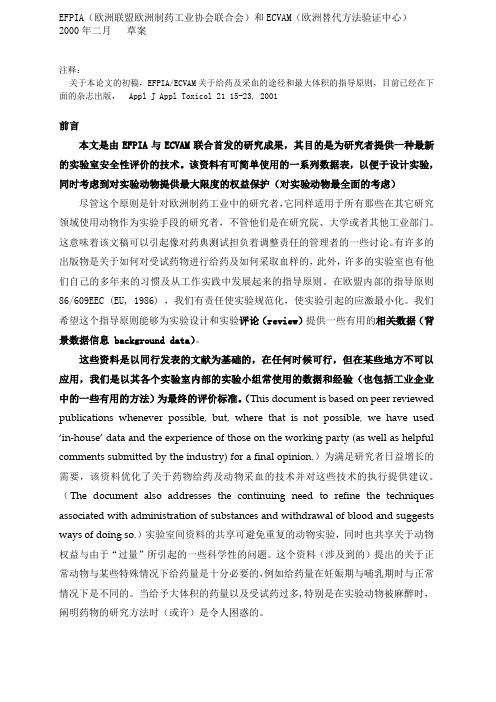
EFPIA(欧洲联盟欧洲制药工业协会联合会)和ECVAM(欧洲替代方法验证中心)2000年二月草案注释:关于本论文的初稿,EFPIA/ECVAM关于给药及采血的途径和最大体积的指导原则,目前已经在下面的杂志出版, Appl J Appl Toxicol 21 15-23, 2001前言本文是由EFPIA与ECVAM联合首发的研究成果,其目的是为研究者提供一种最新的实验室安全性评价的技术。
该资料有可简单使用的一系列数据表,以便于设计实验,同时考虑到对实验动物提供最大限度的权益保护(对实验动物最全面的考虑)尽管这个原则是针对欧洲制药工业中的研究者,它同样适用于所有那些在其它研究领域使用动物作为实验手段的研究者,不管他们是在研究院、大学或者其他工业部门。
这意味着该文稿可以引起像对药典测试担负着调整责任的管理者的一些讨论。
有许多的出版物是关于如何对受试药物进行给药及如何采取血样的,此外,许多的实验室也有他们自己的多年来的习惯及从工作实践中发展起来的指导原则。
在欧盟内部的指导原则86/609EEC (EU, 1986) ,我们有责任使实验规范化,使实验引起的应激最小化。
我们希望这个指导原则能够为实验设计和实验评论(review)提供一些有用的相关数据(背景数据信息 background data)。
这些资料是以同行发表的文献为基础的,在任何时候可行,但在某些地方不可以应用,我们是以其各个实验室内部的实验小组常使用的数据和经验(也包括工业企业中的一些有用的方法)为最终的评价标准。
(This document is based on peer reviewed publications whenever possible, but, where that is not possible, we have used ‘in-house’ data and the experience of those on the working party (as well as helpful comments submitted by the industry) for a final opinion.)为满足研究者日益增长的需要,该资料优化了关于药物给药及动物采血的技术并对这些技术的执行提供建议。
动物免疫与动物采血实验操作规范
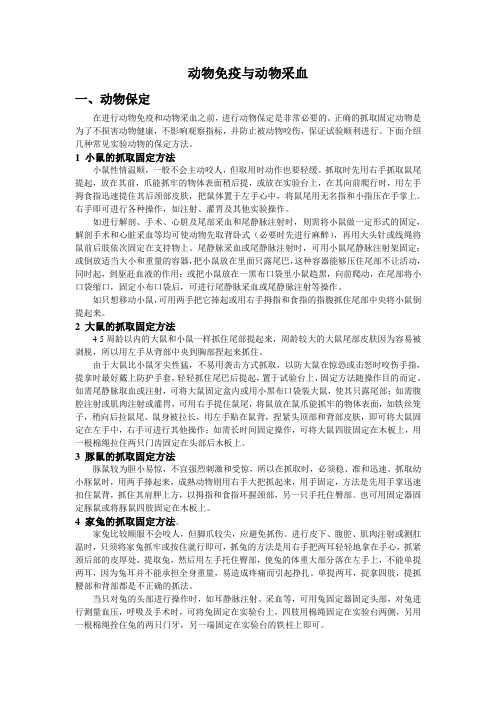
动物免疫与动物采血一、动物保定在进行动物免疫和动物采血之前,进行动物保定是非常必要的。
正确的抓取固定动物是为了不损害动物健康,不影响观察指标,并防止被动物咬伤,保证试验顺利进行。
下面介绍几种常见实验动物的保定方法。
1 小鼠的抓取固定方法小鼠性情温顺,一般不会主动咬人,但取用时动作也要轻缓。
抓取时先用右手抓取鼠尾提起,放在其前,爪能抓牢的物体表面稍后提,或放在实验台上,在其向前爬行时,用左手拇食指迅速提住其后颈部皮肤,把鼠体置于左手心中,将鼠尾用无名指和小指压在手掌上。
右手即可进行各种操作,如注射、灌胃及其他实验操作。
如进行解剖、手术、心脏及尾部采血和尾静脉注射时,则需将小鼠做一定形式的固定,解剖手术和心脏采血等均可使动物先取背卧式(必要时先进行麻醉),再用大头针或线绳将鼠前后肢依次固定在支持物上。
尾静脉采血或尾静脉注射时,可用小鼠尾静脉注射架固定;或倒放适当大小和重量的容器,把小鼠放在里面只露尾巴,这种容器能够压住尾部不让活动,同时起,到驱赶血液的作用;或把小鼠放在一黑布口袋里小鼠趋黑,向前爬动,在尾部将小口袋缩口,固定小布口袋后,可进行尾静脉采血或尾静脉注射等操作。
如只想移动小鼠,可用两手把它捧起或用右手拇指和食指的指腹抓住尾部中央将小鼠倒提起来。
2 大鼠的抓取固定方法4-5周龄以内的大鼠和小鼠一样抓住尾部提起来,周龄较大的大鼠尾部皮肤因为容易被剥脱,所以用左手从背部中央到胸部捏起来抓住。
由于大鼠比小鼠牙尖性猛,不易用袭击方式抓取,以防大鼠在惊恐或击怒时咬伤手指,提拿时最好戴上防护手套,轻轻抓住尾巴后提起,置于试验台上,固定方法随操作目的而定。
如需尾静脉取血或注射,可将大鼠固定盒内或用小黑布口袋装大鼠,使其只露尾部;如需腹腔注射或肌肉注射或灌胃,可用右手提住鼠尾,将鼠放在鼠爪能抓牢的物体表面,如铁丝笼子,稍向后拉鼠尾、鼠身被拉长,用左手贴在鼠背,捏紧头顶部和背部皮肤,即可将大鼠固定在左手中,右手可进行其他操作;如需长时间固定操作,可将大鼠四肢固定在木板上,用一根棉绳拉住两只门齿固定在头部后木板上。
- 1、下载文档前请自行甄别文档内容的完整性,平台不提供额外的编辑、内容补充、找答案等附加服务。
- 2、"仅部分预览"的文档,不可在线预览部分如存在完整性等问题,可反馈申请退款(可完整预览的文档不适用该条件!)。
- 3、如文档侵犯您的权益,请联系客服反馈,我们会尽快为您处理(人工客服工作时间:9:00-18:30)。
A Good Practice Guide to the Administration of Substances and Removal of Blood,Including Routes and Volumes良好的实验动物给药和采血(包括途径和体积)规范指南Karl-Heinz Diehl1, Robin Hull2, David Morton3, Rudolf Pfister4, Yvon Rabemampianina5,David Smith6,*, Jean-Marc Vidal7 and Cor van de Vorstenbosch 81Aventis, PO Box 1140, D35001 Marburg, Germany德国马尔堡市35001区1140信箱安万特公司2N I B S C, Blanch Lane, South Miimms, Potters Bar, Hertfordshire EN6 3QG英国赫特福德郡EN6 3QG波特斯巴镇South Miimms布兰奇道英国国家生物制品检定所3The University of Birmingham, Medical School, Edgbaston, Birmingham B15 2TT英国伯明翰市B15 2TT艾吉马斯顿伯明翰大学医学院4Novartis Pharma AG, CH-4002 Basel, Switzerland瑞士巴塞尔CH-4002诺华制药公司5Centre de Recherche Pfizer, Etablissement d’Amboise, Z1 Poce´-sur-Cisse-BP 159 37401 Amboise Cedex, France法国Amboise Cedex Z1 Poce´-sur-Cisse-BP 159 37401 Etablissement d’Amboise 辉瑞研究中心6AstraZeneca R&D Charnwood, Bakewell Road, Loughborough, Leics LE11 5RH英国莱斯特郡LE11 5RH拉夫堡市贝克韦尔路Charnwood阿斯利康研究中心7Aventis, 102 Route de Noisy, 95235 Romainville Ce´dex, France法国Romainville Ce´dex 95235 Noisy路102号安万特公司8N V Organon, PO Box 20, 5340 BH Oss, Netherlands荷兰BH Oss5340 20号信箱欧加农公司Key words: blood volumes; blood removal; administration substances; laboratory animals; refinement.关键词:血容量;采血;给药;实验动物;简化This article is the result of an initiative between the European Federation of Pharmaceutical Industries Associations (EFPIA) and the European Centre for the Validation of Alternative Methods (ECVAM).Its objectives are to provide the researcher in the safety evaluation laboratory with an up-to-date, easyto-use set of data sheets to aid in the study design process whilst at the same time affording maximum welfare considerations to the experimental animals.该文章为欧盟制药工业协会(EFPIA)和欧洲替代动物实验方法验证中心(ECVAM)之间的初步结果。
其目的在于为安全性评价实验室的研究者提供最新的易于使用的数据库以帮助研究设计过程,同时最大可能地考虑到实验动物的福利。
Although this article is targeted at researchers in the European Pharmaceutical Industry, it is considered that the principles underpinning the data sets and refinement proposals are equally applicable to all those who use these techniques on animals in their research, whether in research institutes,universities or other sectors of industry. The implications of this article may lead to discussion with regulators, such as those responsible for pharmacopoeial testing.尽管该文章针对的是欧洲制药工业界的研究者,但支撑该数据库的基本原理及改进建议同样适用于所有在他们的研究中使用这些动物实验技术的人,不论是研究所、大学或其它行业中的研究者。
There are numerous publications dealing with the administration of test substances and the removal of blood samples, and many laboratories also have their own ‘in-house’ guidelines that have been developed by custom and practice over many years. Within European Union Directive 86/609EEC1 we have an obligation to refine experiments to cause the minimum amount of stress. We hope that this article will provide background data useful to those responsible for protocol design and review.有关供试品给予和采血的出版物众多,且许多实验室在多年的经验和实践基础之上亦发展了它们自己的内部指南。
在欧盟化妆品标准86/609EEC中,我们有义务简化实验以最小化动物的紧张程度。
我们希望该文能够对那些负责方案设计和审核的研究者提供有用的背景数据。
This guide is based on peer-reviewed publications whenever possible, but where this is not possible we have used ‘in-house’data and the experience of those on the working party (as well as helpful comments submitted by the industry) for a final opinion. The guide also addresses the continuing need to refine the techniques associated with the administration of substances and the withdrawal of blood, and suggests ways of doing so. Data-sharing between laboratories should be encouraged to avoid duplication of animal work, as well as sharing practical skills concerning animal welfare and scientific problems caused by ‘overdosing’ in some way or another. The recommendations in this guide refer to the ‘normal’animal, and special consideration is needed, for instance, during pregnancy and lactation.Interpretation of studies may be confounded when large volumes are administered or excessive sampling employed, particularly if anaesthetics are used. Copyright ã 2001 John Wiley & Sons, Ltd.该文章基于历年所有可能收集到的同行评议出版物,但我们未能够收集到的内部数据和那些工作组的经验(以及行业提交的有用的注释)除外。
该指南亦强调了持续性简化与给药和采血有关的技术的必要性,并且建议该如何去进行这方面的工作。
应该鼓励实验室间的数据共享以避免重复性动物研究,以及共享在某些方法或其它情况下的“药物过量”所引起的与动物福利有关的实际技术和科学问题。
有必要对该指南中涉及到的“正常动物”要求进行特殊考虑,如妊娠和哺乳期间的动物。
当给药体积较大或过度采样时对研究结果的诠释可能会令人感到困惑,特别是使用麻醉动物时。
GOOD PRACTICE GUIDE FOR ADMINISTRATION OF SUBSTANCES良好的给药规范指南Introduction引言Dosing of experimental animals is necessary for a variety of scientific investigations and to meet regulatory demands. The pharmaceutical industry, in particular,has investigated the levels of dosing compatible with animal welfare and valid science.2 In the preclinical stage of the safety evaluation of new drugs it is normal practice to use multiples of the ‘effective dose’in order to attempt to establish the necessary safety margins. Where chemicals are of low toxicity or are only poorly soluble in acceptable formulations, a large volume may be required to be given to individual animals to satisfy both scientific and regulatory requirements.The intended clinical use may also have an impact on the acceptability of larger than usual dose volumes, e.g. imaging agents or plasma expanders for intravenous application.各种科学研究都需要对实验动物给药以符合药品注册要求。
